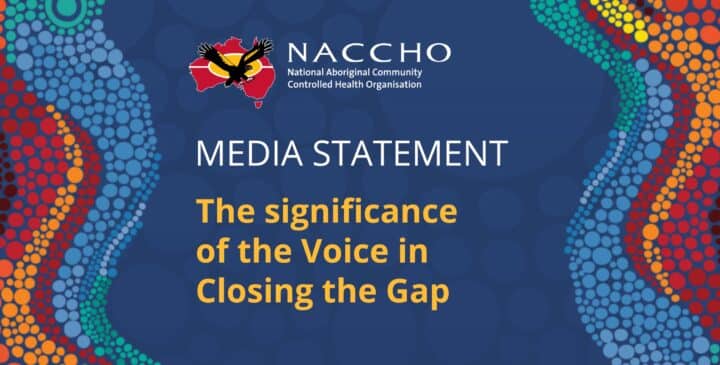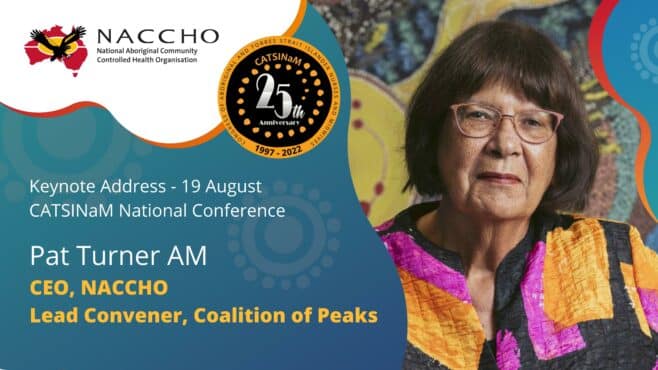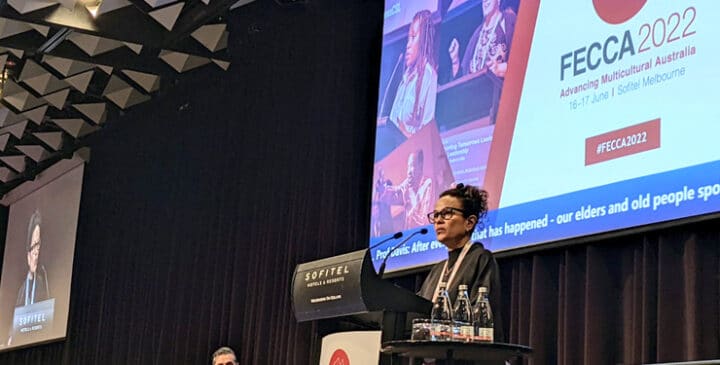

NACCHO CEO Pat Turner’s keynote speech at the National Reconciliation Week Virtual Breakfast 2020 presented by Reconciliation SA.
Good morning everyone, thank you for inviting me here today. My name is Pat Turner, and I am the daughter of an Arrente man and a Gurdanji woman. I am also the CEO of the National Aboriginal Community Controlled Health Organisation (NACCHO), and the Lead Convener of the Coalition of Aboriginal and Torres Strait Islander Community-Controlled Peak organisations. Before we start, I want to acknowledge the traditional custodians of all the lands that we are meeting upon today. I am speaking to you from Canberra, which is Ngunnawal country. I also want to acknowledge and thank Reconciliation South Australia for the opportunity to be the keynote speaker for your annual breakfast, in this case I assume the first ever virtual one. Peter Buckskin, a co-chair of Reconciliation South Australia, and I worked together in ATSIC and he has made a great contribution to improving life outcomes for our people. Meanwhile, Shona Reid is Eastern Arrente, and like me we can both trace our ancestry back to Central Australia with pride. I truly believe that Aboriginal and Torres Strait Islander people continue to be impacted by the legacy of colonisation in every aspect of our lives. But what also continues is our resilience amidst the adversity we face. When we face adversity together, we see stronger outcomes. Accordingly, today I would like to talk about the topic of ‘In This Together’. I would like to focus on four aspects of what togetherness looks like currently for our people — aspects that we can and must build upon. First, I want you all to know about how Aboriginal and Torres Strait Islander community-controlled organisations came together from across the nation to form the Coalition of Aboriginal and Torres Strait Islander Community-Controlled Peak Organisations. Second, I want to discuss the unprecedented opportunity we have for genuine shared decision-making in the Partnership Agreement between the Council of Australian Governments (COAG) and the Coalition of Peaks. Third, I want to alert you to the negotiations now underway to finalise a new National Agreement on Closing the Gap, which came out of the Partnership Agreement that also advances this idea of ‘In this Together’. Fourth, without engaging in any premature celebrations whatsoever, as we still have a long way to go, I will talk about the strong, coordinated work of Aboriginal Community Controlled Health Organisations that have come together from across Australia to successfully protect our people from to COVID-19. I will then bring together the four — how the work of the Coalition of Peaks can help in optimising the health and wellbeing of our people and communities amidst the impacts of the pandemic. Number one – Coalition of Peaks Our people have lived in a climatically harsh country for more than sixty thousand years, which has required great knowledge and custodianship of the environment and close cooperation between our people to succeed. This cooperation continues to be evident in our recent collaboration in forming the Coalition of Peaks to make sure that we share decision making in relation to Closing the Gap. The Coalition of Peaks comprises nearly 50 national, State and Territory community-controlled Aboriginal and Torres Strait Islander peak organisations. This is every community-controlled peak organisation in Australia. They include NACCHO, SNAICC – National Voice for our Children, the NSW Aboriginal Land Council, First Peoples Disability Network and First Nations Media Australia. The Aboriginal Legal Rights Movement has led South Australia’s involvement in the Coalition of Peaks. To its credit, it has facilitated the establishment of the South Australian Aboriginal Community Controlled Organisation Network that has brought together other Aboriginal peaks in South Australia to work together at the state level. Never have community controlled peak bodies and organisations come together in this way – to develop policy and negotiate with governments. Number two – The Partnership Agreement between the Coalition of Peaks and COAG The historic Partnership Agreement, which commenced in March 2019 and is a public document, was also an initiative of the Coalition of Peaks. Of most importance is that the signatories are COAG and the Coalition of Peaks – that is, legitimately appointed community representatives of Aboriginal and Torres Strait Islander communities from across Australia. We proposed the Partnership Agreement after gaining the support of the Prime Minister and the Council of Australian Governments to a partnership being formed with representatives of Aboriginal and Torres Strait Islander people to underpin the next phase of Closing the Gap. Prior to this, COAG had decided on its own to refresh the Closing the Gap strategy that was originally agreed to in 2008 and given effect to by the National Indigenous Reform Agreement. To do this refresh, in 2018 COAG undertook a series of consultations with Aboriginal and Torres Strait Islander people across Australia — which were inadequate and lacked transparency. While the rhetoric was about partnership, there was no real commitment to it and the refresh was proceeding on the basis that COAG would make all the decisions. To be frank, at this point in time, we did not consider we were ‘In This Together’ with them. NACCHO and other community-controlled peaks decided that this could not continue and took a risk in publicly insisting that we be able to share decisions about the Closing the Gap strategy instead of COAG making decisions on its own. We wrote to all First Ministers to put forward three (3) main propositions— When Aboriginal and Torres Strait Islander peoples are included and have a real say in the design and delivery of services that impact on them, the outcomes are far better; Aboriginal and Torres Strait Islander peoples need to be at the centre of Closing the Gap policy; the gap won’t close without our full involvement; and COAG cannot expect us to take responsibility and work constructively with them to improve outcomes if we are excluded from decision making. Under the Partnership Agreement, the Coalition of Peaks are already sharing decision making on developing, implementing, monitoring and reviewing the Closing the Gap strategy for the next ten years. A new COAG Council, the Joint Council on Closing the Gap, is also established under the Partnership Agreement. For the first time, this COAG Council has members from outside Governments. In fact, it has 12 members elected from the Coalition of Peaks including a representative from each jurisdiction. Ruth Miller is the representative for South Australia. In addition, each jurisdiction nominates a Minister with responsibilities for Closing the Gap. It is co-chaired by the Federal Minister, Minister Wyatt, and me. Number 3 – the new National Agreement on Closing the Gap Following a review of the National Indigenous Reform Agreement, the Joint Council on Closing the Gap agreed that it should be replaced with a new National Agreement on Closing the Gap. Joint Council also agreed that the new Agreement should not only be signed by First Ministers but also the Coalition of Peaks on behalf of Aboriginal and Torres Strait Islander people. That is incredibly significant for our people and for Australia. Once in place, the National Agreement will be a platform to address the structural inequalities Aboriginal and Torres Strait Islander people face arising from years of unmet need. Instead of targets being the focus, which was the case with the National Indigenous Reform Agreement, the Coalition of Peaks have also gained support from the Joint Council and all Governments that four priority reforms will underpin the new National Agreement. These are:
- establishing formal partnerships between governments and Aboriginal and Torres Strait Islander representatives across the country on closing the gap
- building and strengthening our community-controlled organisations to deliver the services we need
- transforming mainstream agencies and institutions of governments, such as the police and universities, to make a much bigger contribution to Closing the Gap; and
- ensuring government data and information is shared with Aboriginal and Torres Strait Islander organisations and communities to support us being able to make good decisions about our lives.
Finally, Joint Council also agreed to the Coalition of Peaks leading engagements with representatives of Aboriginal and Torres Strait Islander people across Australia to see what they thought about the priority reforms and what else should be included in the new National Agreement. Those engagements took place between September and December last year including in South Australia and included an online survey and over 4000 Aboriginal and Torres Strait Islander people had a say. We have published the outcomes of those engagements and are making sure that what people said is reflected in the Agreement currently being negotiated with COAG. Number 4 – Our ACCHO’s and communities’ coordinated COVID-19 response I would also like to speak on our ACCHO’s and communities’ coordinated COVID-19 response. Only three months ago the Prime Minister announced to the nation that last year the gap in infant mortality rates between Aboriginal and Torres Strait Islander people and other Australians increased. In the three months since then COVID-19 has been a whole new stark reminder to us all just how vulnerable the health of our people is. We have been reminded of the significantly greater risk we face of being profoundly impacted due to the pre-existing co-morbidities many of us battle. The pandemic has highlighted the fault lines of disadvantage endured by Aboriginal and Torres Strait Islander peoples for generations, from health and education to housing. Overcrowded housing, poverty and other social determinants are the root cause of Aboriginal and Torres Strait Islander peoples being at high risk from pandemics and other communicable diseases. The pandemic has exposed what we have been advocating for decades – better and less crowded housing for our people. Overcrowding makes self-isolation and stopping the spread of a virus incredibly difficult, if not impossible. NACCHO continues to advocate for greater federal, state and territory investment in housing for our people, and for housing initiatives to be developed in genuine partnership with us. And as we know, there will be long term social, economic, health and cultural costs of the pandemic. The risk facing our communities is a direct result of years of neglect, disinvestment and failed policies and programs that have been developed without our input. But our organisations and communities are best placed to respond to this crisis and to drive progress towards the longer-term priority of closing of the gap in life outcomes between Aboriginal and Torres Strait Islander people and other Australians. The Aboriginal Community Controlled Health Sector began actively preparing to respond to a possible COVID-19 outbreak in January 2020, in advance of the public response by the government. As a result, many of our ACCHOs had a level of preparedness prior to the pandemic which many general practices could not match. This pandemic has demonstrated the community-controlled health sector collaborates extremely well, and the high level of information sharing and joint decision making must continue into the future. Throughout the pandemic, the Government has been committed to taking the advice of our community controlled health sector, and listening to the recommendations of the Aboriginal and Torres Strait Islander Advisory Group on COVID-19 to implement response plans to keep our mob safe. Those of our organisations with strong existing partnerships with governments have been able to respond quickly to the threat of COVID-19. Well-established and properly funded community-controlled organisations across numerous sectors have been able to accelerate measures that support our communities. One example is the formal relationship between governments and Aboriginal Peaks Organisations in the Northern Territory (APONT) and the Aboriginal Advisory Council of Western Australia, which has enabled an informed response to the needs of our remote communities impacted by the swift travel restrictions out in place. Other examples include — First Nation’s media sector has been able to get health information out quickly in a way that people can understand The New South Wales Coalition of Peaks has supported our young people to stay engaged in their education and make sure our older people have access to food, and The Victorian Aboriginal Executive Council is working to make sure our kids continue to have access to safe early childhood services. What NACCHO and our Affiliates and ACCHOs have been doing During these past few months ACCHOs have once again proven themselves to be the best in the business at —
- knowing our people
- our people feeling safe to access our services
- being a well-established sector
- having strong formal relationships with government
Together, collectively and nationally, as a sector we have been able to respond quickly and decisively to protect our people. This is despite our ACCHOs and other Aboriginal community-controlled organisations having borne the brunt of repeated funding cuts and a roller coaster of policy and administration changes. As soon as it became evident in January just how deadly the COVID-19 virus was, well in advance of the Commonwealth response, NACCHO, our Affiliates and Members initiated awareness campaigns for our communities and planning for prevention and response. Before the first case of coronavirus in Australia our communities were preparing to close borders, and Aboriginal and Torres Strait Islander health experts were discussing measures needed to protect our mob across the nation. In January I began sending COVID-19 health messages to all our Affiliates and ACCHOs, with gave me the opportunity to ask them how prepared they felt they were for the impending pandemic. It was clear there were PPE shortages in many clinics, and concerns around how to prepare a pandemic response — including quarantine measures. ACCHOs are barely funded for their regular day to day activities, let alone for a pandemic response. I discussed options with the Department of Health for ways additional funding for ACCHOs and Affiliates to support the preparation of pandemic plans. The government was receptive of the advice I provided and allocated $6.9 million to NACCHO and Affiliates to prepare a pandemic response and $5 million to assist remote communities prepare for COVID-19. I also wrote to the Prime Minister on 16 March to propose a range of specific measures which needed to be taken to protect our communities. The government again responded positively from the outset, and this spirit of collaboration has been crucial to our successful response to the pandemic. With our Affiliates and ACCHOs in WA, the NT and QLD I strongly argued for the immediate application of travel restrictions and quarantine measures to protect our people and communities, and for urgent additional support to be deployed to Affiliates and ACCHOs to combat the virus. I continue to pursue funding for quarantine/isolation facilities for remote, urban and regional communities which will be critical if we are going to properly manage an outbreak in our communities. NACCHO has been sharing important public health messages and culturally appropriate COVID-19 news alerts and posts on our blog and across all social media platforms, and launched a dedicated COVID-19 website page. And our Affiliates and ACCHOs — they have initiated their own creative and innovative awareness campaigns for our communities in January. These campaigns have been successful because they were created by Aboriginal people, health groups and organisations for Aboriginal people and communities. ACCHOs are busily facilitating phone consults, home visits to Elders and those self-isolating and seeing some patients at the clinic for flu vaccinations. All the while, despite staff and equipment shortages and the challenges of working in a restricted environment due to lockdown, our ACCHOs have not wavered from treating those in our communities with chronic conditions as they continue to provide their comprehensive primary health services to their communities. Up to now, as a sector, together, we have done exceptionally well, keeping infections out of our communities. As of 3 May 2020, only fifty-five cases (0.8% of all cases tested) have been people identifying as Aboriginal and/or Torres Strait Islander. There have been absolutely no cases in our remote or very remote communities. But, as stated earlier, there is a long way to go. NACCHO and our Affiliates will continue to work collaboratively with the different tiers of government throughout this crisis, including pointing out the danger of moving too quickly to relax restrictions without a clear roadmap. Conclusion Despite the tireless work of our ACCHOs and other Aboriginal and Torres Strait Islander organisations, there is a clear absence in this time of crisis of a national policy platform for governments to systemically re-build our communities and address the inequities too many of our people continue to face. There is also a clear absence of an Aboriginal and Torres Strait Islander national body for pooling collective expertise to work in partnership with governments to respond to the impacts of the pandemic. It is because of this policy and process vacuum that the Coalition of Peaks was formed and why we have been continuing our work, in partnership with Australian governments, to chart a meaningful way forward, across a range of sectors and initiatives for bringing about real, sustained change. The new National Agreement and the Coalition of Peaks will be crucial to rebuilding our communities post-pandemic. The federal, state, territory and local governments must continue to work in full partnership with the Coalition of Peaks as a collective and as individual members to ensure that we emerge from this crisis stronger. And, I must add, this pandemic cannot and should not be used by anyone as a reason to delay the finalisation of the new National Agreement on Closing the Gap. The pandemic has disrupted governments, but it has disrupted us also. Community-controlled organisations, including in health, have had to face much bigger workloads. Nevertheless, we have continued to work to finalise the National Agreement and we expect governments to do the same. Our response to the pandemic can and must galvanise our collective efforts and sharpen our focus to the task of closing the gap. The National Agreement must be sorted by mid-July and I am confident this is achievable. If it isn’t, we risk the Agreement being put on the “never- never” because of upcoming elections in jurisdictions like Queensland and the Northern Territory and because governments will be pre-occupied with their delayed budgets. I ask all participants in this virtual Breakfast, and in fact make a call to Australia, that everyone support the leadership of the Coalition of Peaks, made up of our own community controlled organisations, in achieving a new Closing the Gap agreement. There is no better demonstration or more important priority for being ‘In This Together’.

